There is so much confusion and stress for chicken keepers about how to keep baby chicks warm safely. Heat lamps are deadly dangerous, routinely overheat chicks, they don’t allow normal light/dark sleep cycles to occur and are confusing to use; what temperature should the brooder be at any given day- do I need a thermometer- if so, where should it be located- when should the heat lamp be raised- when can the heat lamp be shut off permanently- are the chicks too cold, too hot, too noisy, too quiet?
Oye! It’s enough to drive any chicken keeper right over the edge with worry. We should worry, but less about chick comfort and more about the fire hazard heat lamps pose. The inherent danger of heat lamps should terrify us! How can we ensure chicks are cared for properly without risking lives and property? The key is to think like a mother hen. Understanding how a mother hen cares for her chicks is the key to doing it safely ourselves.
A heat lamp with a red, 250 watt bulb is the most commonly used heat source, but it’s also the most dangerous, most expensive to power and least healthy option for baby chicks. Heat lamps are the worst idea in the history of chicken care. Placing a 500°F surface in a confined area with highly-flammable wood shavings/straw, feathers, water and living creatures is a disaster waiting to happen. Never use bulbs coated with PTFE (polytetrafluoroethylene), which is the same polymer found in nonstick cookware, as it can emit toxic fumes when overheated, killing the chicks.
We are all taught “The Formula” for brooding baby chicks with a heat lamp: 90-95° Fahrenheit for the first week of life, decreasing by five degrees each week thereafter, but experience and mother hens have shown me that The Formula calls for too much constant heat for much too long. I strongly encourage the use of safe heating options such as radiant heat plates. Even placing the brooder in a bathroom with the room’s thermostat cranked up for a few days is a better option than a heat lamp. Radical suggestion? Maybe, but it won’t kill your family, your chickens or burn down your home. Let’s raise chicks, but let’s do it safely.
This video shows Freida, my 7 year old Silkie hen, with her chicks on a day when the low temp was 40° and the high temp was 60°F.
MOTHER KNOWS BEST
A mother hen knows best how to keep chicks warm, she:
- raises chicks in the spring, summer and early autumn when temperatures are moderate
- watches and listens to her chicks
- knows each of her chicks has different needs. Not all chicks require the same degree of warmth at the same time.
- puts safety first. She keeps her chicks safe & warm by pulling them underneath her body with her beak if they don’t have the good sense to find their way there by themselves
A hen’s internal body temp ranges between ~104°-107°F and she keeps a nest of eggs warm against her skin at ~99-100°F until they hatch. Since newly hatched chicks are unable to regulate their own body temperatures, she keeps them underneath her until they are dry and fluffy.
After the first day, she always ensures they sleep underneath her in total darkness and is available to them during they day if they are cold. They roam around eating, exploring and dust bathing until they feel the need to tuck into the hen’s feathers again. After the first week, chicks spend less and less time underneath their mothers. When they are chilly, they simply crawl back underneath their walking feather-bed- and sometimes, on top of her!
The chicks in this video were not hatched by this hen and recently introduced to her. They were a little confused, but she talks to them and gets them settled underneath her warm belly.
A radiant warming unit such as this Brinsea EcoGlow brooder keeps chicks comfortable while they’re underneath it, they do not warm up the air in the brooder as heat lamps do.
HOW TO THINK & ACT LIKE A MOTHER HEN
- Brood very young chicks inside where temperatures are at least 60°F. Very little supplemental heat will be required to get chicks comfortable in a room that is 60-70°F, particularly after the first three days of life.
- Watch and listen to baby chicks: if they are cheeping unhappily in the brooder or are huddled together while awake, they are cold, stressed or lost. Adjust the brooder size, location or room temperature accordingly. There is no need for a thermometer, just common sense
- Noisy chicks are unhappy chicks. Quiet chicks are happy chicks!
- Put safety first. There are many, much safer alternatives to heat lamps including this radiant heat unit. If that means putting an oil-filled space heater in a small bathroom for the first few days after bringing 2 day old chicks home, do that. Aim to provide only as much warmth as they indicate is needed by their behavior. (see videos of happy and unhappy chicks below)
This video shows Mabel getting her chicks to obey her for their own safety.
CASE STUDY
A nervous friend sent me a flurry of text messages with photos of his brooder setup in his 68°F family room the night before his first chicks arrived. The brooder was perfect: feeder, nipple water drinker & EcoGlow chick warmer. Safe and fully furnished.
After he picked up his 6 chicks from the post office, he sent me a photo of his cuties under a heat lamp away from the EcoGlow- I nearly fainted. Using the heat lamp completely defeated the safety of the EcoGlow. I called him to discuss thinking like a mother hen.
He said when he got the chicks home, he placed them underneath the EcoGlow, but they ran away from it to the far end of the stock tank where they huddled noisily. When he turned the heat lamp on, they stopped cheeping, but remained huddled together underneath it. Thinking like a mother hen, we talked it through.
His three day old chicks had just been on dark, bumpy, 2 day ride through the mail and taken out of a dark box into a bright, unfamiliar place. They were scared, confused, hungry, thirsty and cold. They were lost and needed guidance, which a mother hen would have provided by showing them where the food and water were and tucking them underneath her body for warmth.
I told him to turn off the heat lamp and reduce the size of the brooder by making a divider with a piece of cardboard or hardware cloth. Now, the only places the chicks could stand were underneath the EcoGlow or in front of the feeder and drinker. It worked like a charm. They did not have the experience or judgment to know what they needed, so by removing options, they got what they needed.
By dusk that evening, the chicks were happily sleeping underneath the EcoGlow where they remained until sunrise the next morning. He was able to expand the living space, giving them access to the huge stock tank where they contentedly ate, drank, pooped and slept. The room and brooder were a comfortable 68°F- there was no need to blast a 250 watt light bulb over their heads for the next several weeks- they were warm, happy, healthy and rested- just as they would have been if a hen had been caring for them.
Thinking like a mother hen and using common sense in caring for baby chicks keeps everyone safe, happy and healthy!
In this video, the mother hen supervises the chicks’ first dust bath.
In this video, one of these 2-day-old chicks is being treated for spraddle leg; the frantic, high-pitched chirping sounds indicate unhappiness as she struggles to walk for the first time on her splinted legs. (Meanwhile, her siblings can be seen cheering her on as they pick up and drop food, encouraging her to walk to it.)
These are the sounds of happy baby chicks, playing in the sandbox together.–>
More happy chicks in this video-->
Kathy Shea Mormino
Affectionately known internationally as The Chicken Chick®, Kathy Shea Mormino shares a fun-loving, informative style to raising backyard chickens. …Read on


shop my SPONSORS
There is so much confusion and stress for chicken keepers about how to keep baby chicks warm safely. Heat lamps are deadly dangerous, routinely overheat chicks, they don’t allow normal light/dark sleep cycles to occur and are confusing to use; what temperature should the brooder be at any given day- do I need a thermometer- if so, where should it be located- when should the heat lamp be raised- when can the heat lamp be shut off permanently- are the chicks too cold, too hot, too noisy, too quiet?
Oye! It’s enough to drive any chicken keeper right over the edge with worry. We should worry, but less about chick comfort and more about the fire hazard heat lamps pose. The inherent danger of heat lamps should terrify us! How can we ensure chicks are cared for properly without risking lives and property? The key is to think like a mother hen. Understanding how a mother hen cares for her chicks is the key to doing it safely ourselves.
A heat lamp with a red, 250 watt bulb is the most commonly used heat source, but it’s also the most dangerous, most expensive to power and least healthy option for baby chicks. Heat lamps are the worst idea in the history of chicken care. Placing a 500°F surface in a confined area with highly-flammable wood shavings/straw, feathers, water and living creatures is a disaster waiting to happen. Never use bulbs coated with PTFE (polytetrafluoroethylene), which is the same polymer found in nonstick cookware, as it can emit toxic fumes when overheated, killing the chicks.
We are all taught “The Formula” for brooding baby chicks with a heat lamp: 90-95° Fahrenheit for the first week of life, decreasing by five degrees each week thereafter, but experience and mother hens have shown me that The Formula calls for too much constant heat for much too long. I strongly encourage the use of safe heating options such as radiant heat plates. Even placing the brooder in a bathroom with the room’s thermostat cranked up for a few days is a better option than a heat lamp. Radical suggestion? Maybe, but it won’t kill your family, your chickens or burn down your home. Let’s raise chicks, but let’s do it safely.
This video shows Freida, my 7 year old Silkie hen, with her chicks on a day when the low temp was 40° and the high temp was 60°F.
MOTHER KNOWS BEST
A mother hen knows best how to keep chicks warm, she:
- raises chicks in the spring, summer and early autumn when temperatures are moderate
- watches and listens to her chicks
- knows each of her chicks has different needs. Not all chicks require the same degree of warmth at the same time.
- puts safety first. She keeps her chicks safe & warm by pulling them underneath her body with her beak if they don’t have the good sense to find their way there by themselves
A hen’s internal body temp ranges between ~104°-107°F and she keeps a nest of eggs warm against her skin at ~99-100°F until they hatch. Since newly hatched chicks are unable to regulate their own body temperatures, she keeps them underneath her until they are dry and fluffy.
After the first day, she always ensures they sleep underneath her in total darkness and is available to them during they day if they are cold. They roam around eating, exploring and dust bathing until they feel the need to tuck into the hen’s feathers again. After the first week, chicks spend less and less time underneath their mothers. When they are chilly, they simply crawl back underneath their walking feather-bed- and sometimes, on top of her!
The chicks in this video were not hatched by this hen and recently introduced to her. They were a little confused, but she talks to them and gets them settled underneath her warm belly.
A radiant warming unit such as this Brinsea EcoGlow brooder keeps chicks comfortable while they’re underneath it, they do not warm up the air in the brooder as heat lamps do.
HOW TO THINK & ACT LIKE A MOTHER HEN
- Brood very young chicks inside where temperatures are at least 60°F. Very little supplemental heat will be required to get chicks comfortable in a room that is 60-70°F, particularly after the first three days of life.
- Watch and listen to baby chicks: if they are cheeping unhappily in the brooder or are huddled together while awake, they are cold, stressed or lost. Adjust the brooder size, location or room temperature accordingly. There is no need for a thermometer, just common sense
- Noisy chicks are unhappy chicks. Quiet chicks are happy chicks!
- Put safety first. There are many, much safer alternatives to heat lamps including this radiant heat unit. If that means putting an oil-filled space heater in a small bathroom for the first few days after bringing 2 day old chicks home, do that. Aim to provide only as much warmth as they indicate is needed by their behavior. (see videos of happy and unhappy chicks below)
This video shows Mabel getting her chicks to obey her for their own safety.
CASE STUDY
A nervous friend sent me a flurry of text messages with photos of his brooder setup in his 68°F family room the night before his first chicks arrived. The brooder was perfect: feeder, nipple water drinker & EcoGlow chick warmer. Safe and fully furnished.
After he picked up his 6 chicks from the post office, he sent me a photo of his cuties under a heat lamp away from the EcoGlow- I nearly fainted. Using the heat lamp completely defeated the safety of the EcoGlow. I called him to discuss thinking like a mother hen.
He said when he got the chicks home, he placed them underneath the EcoGlow, but they ran away from it to the far end of the stock tank where they huddled noisily. When he turned the heat lamp on, they stopped cheeping, but remained huddled together underneath it. Thinking like a mother hen, we talked it through.
His three day old chicks had just been on dark, bumpy, 2 day ride through the mail and taken out of a dark box into a bright, unfamiliar place. They were scared, confused, hungry, thirsty and cold. They were lost and needed guidance, which a mother hen would have provided by showing them where the food and water were and tucking them underneath her body for warmth.
I told him to turn off the heat lamp and reduce the size of the brooder by making a divider with a piece of cardboard or hardware cloth. Now, the only places the chicks could stand were underneath the EcoGlow or in front of the feeder and drinker. It worked like a charm. They did not have the experience or judgment to know what they needed, so by removing options, they got what they needed.
By dusk that evening, the chicks were happily sleeping underneath the EcoGlow where they remained until sunrise the next morning. He was able to expand the living space, giving them access to the huge stock tank where they contentedly ate, drank, pooped and slept. The room and brooder were a comfortable 68°F- there was no need to blast a 250 watt light bulb over their heads for the next several weeks- they were warm, happy, healthy and rested- just as they would have been if a hen had been caring for them.
Thinking like a mother hen and using common sense in caring for baby chicks keeps everyone safe, happy and healthy!
In this video, the mother hen supervises the chicks’ first dust bath.
In this video, one of these 2-day-old chicks is being treated for spraddle leg; the frantic, high-pitched chirping sounds indicate unhappiness as she struggles to walk for the first time on her splinted legs. (Meanwhile, her siblings can be seen cheering her on as they pick up and drop food, encouraging her to walk to it.)
These are the sounds of happy baby chicks, playing in the sandbox together.–>
More happy chicks in this video-->



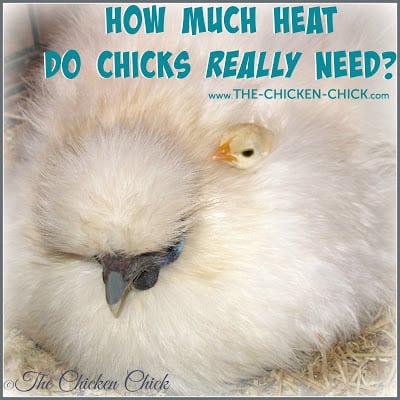

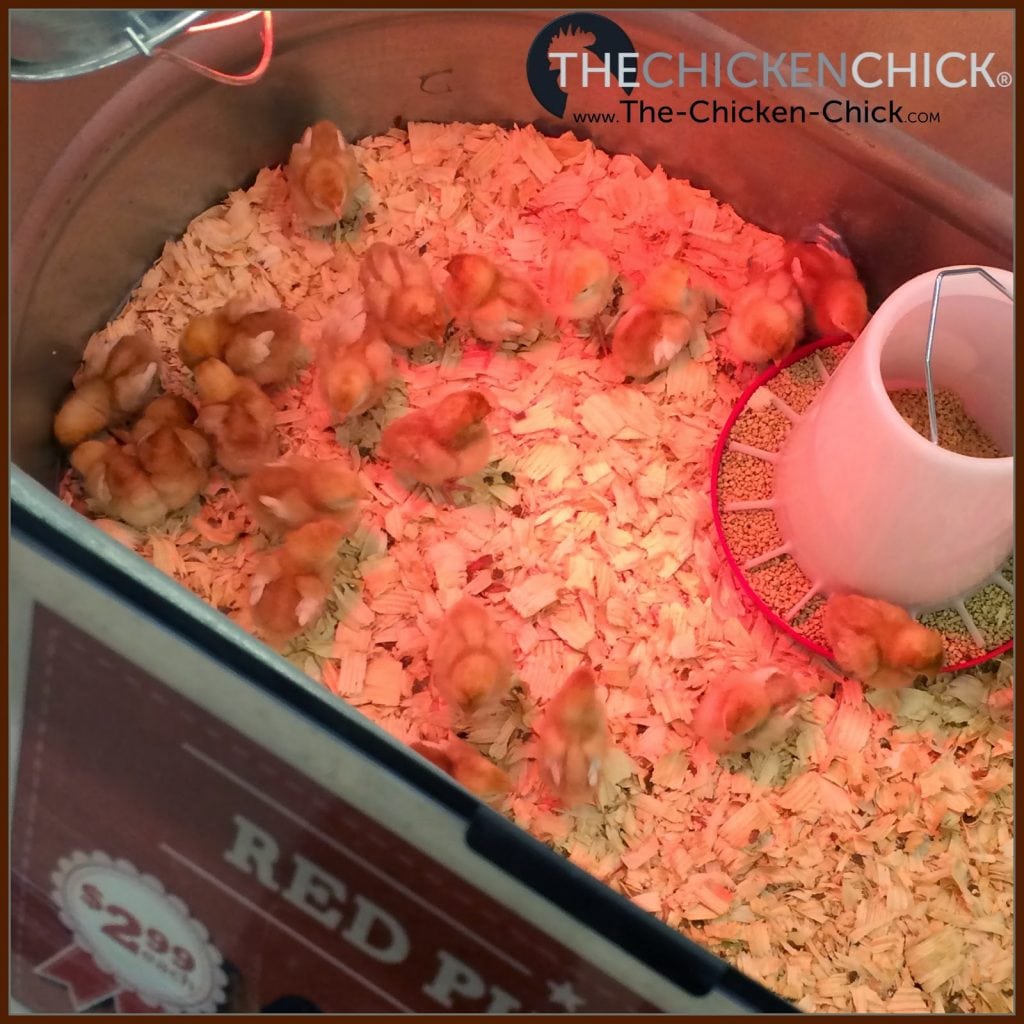
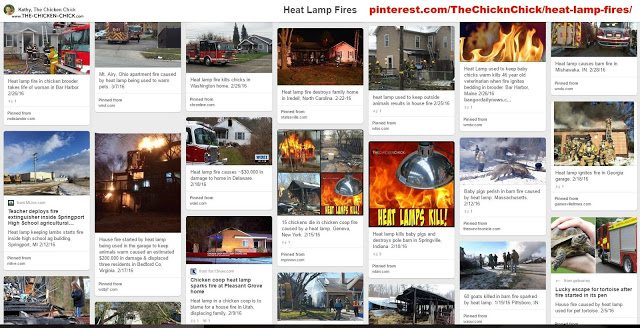
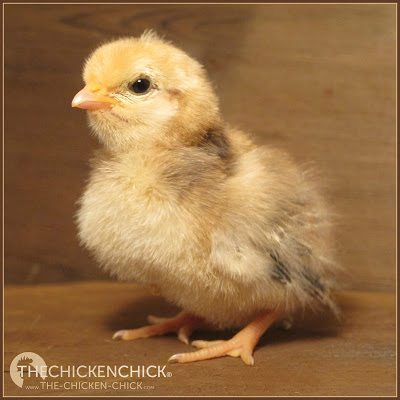
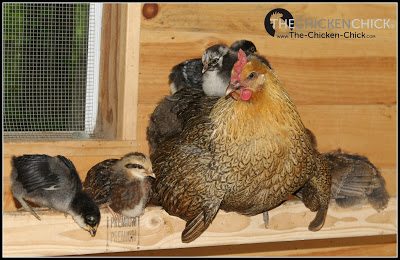
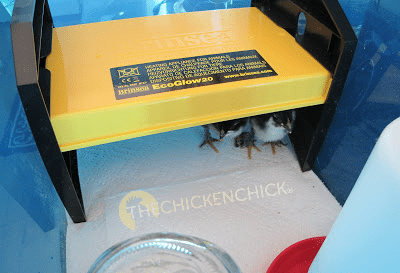
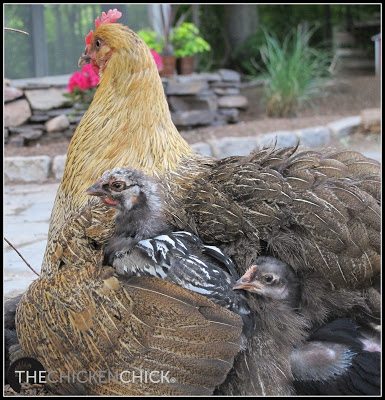
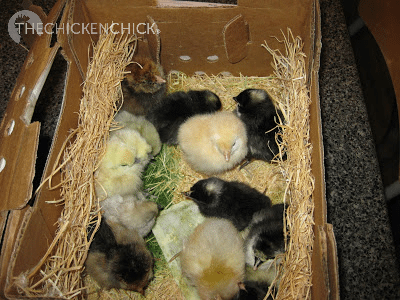
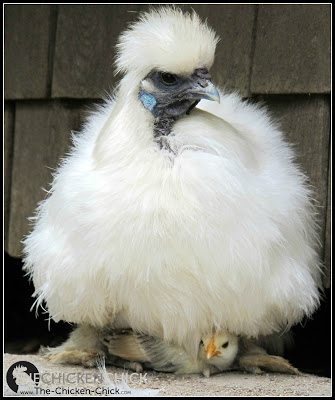















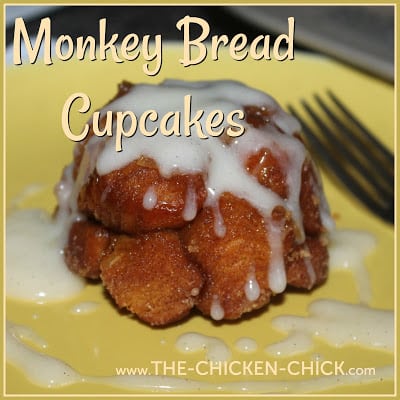









Hope to win!
I’ve got 1 month old Welsumers in the brooder. I will be moving them to a growing pen this next week. I have more Welsumer eggs and Easter eggs in the bater that will hatch next Wednesday. Now I am wishing I had two Brinsea brooder a. I think the older chicks will be ok with a safely placed 60 watt light. Owi they aren’t use to this.
Baby chicks on the way!!!!! Thanks for the opportunity of a healthy start :)
Thanks. I am getting chicks April 3rdish and don’t have a ego heater. So I am making a tunnel with hardware cloth and a heating pad. They will have the warmth and close contact with the heating pad and also darkness. I was trying to think like a hen! LOL
this would be great for my newest babies, 2 New Hampshire and 3 Isa Browns. They are 4 weeks old, and I loved the temperature article. I have not kept my babies under such high temps either and they are all doing fabulous. I used a K&H thermo chicken heating pad for the first 3 weeks and now nothing.